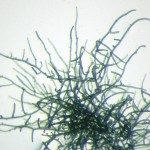Link to Pubmed [PMID] – 23221676
Genome Biol Evol 2013;5(1):31-44
Cyanobacteria forged two major evolutionary transitions with the invention of oxygenic photosynthesis and the bestowal of photosynthetic lifestyle upon eukaryotes through endosymbiosis. Information germane to understanding those transitions is imprinted in cyanobacterial genomes, but deciphering it is complicated by lateral gene transfer (LGT). Here, we report genome sequences for the morphologically most complex true-branching cyanobacteria, and for Scytonema hofmanni PCC 7110, which with 12,356 proteins is the most gene-rich prokaryote currently known. We investigated components of cyanobacterial evolution that have been vertically inherited, horizontally transferred, and donated to eukaryotes at plastid origin. The vertical component indicates a freshwater origin for water-splitting photosynthesis. Networks of the horizontal component reveal that 60% of cyanobacterial gene families have been affected by LGT. Plant nuclear genes acquired from cyanobacteria define a lower bound frequency of 611 multigene families that, in turn, specify diazotrophic cyanobacterial lineages as having a gene collection most similar to that possessed by the plastid ancestor.


